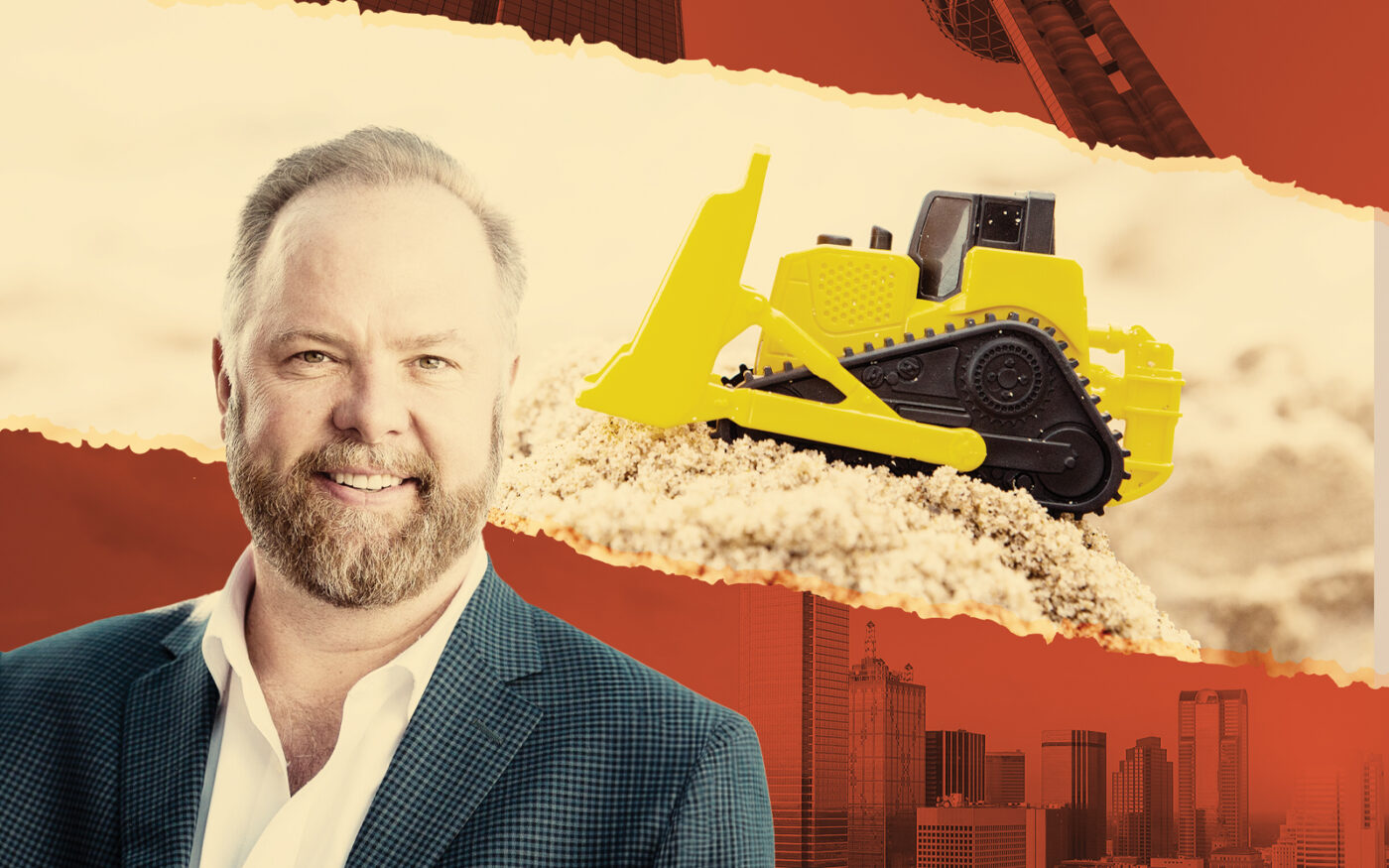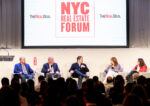How Ken Good Jr. perfects the art of Class B office in DFW
The second-generation developer hunts in the office building bargain bin

For the better part of 30 years, Ken Good Jr. has stuck to his sandbox.
The Texas-born, Denver-based developer’s niche is collecting the washed-away sandcastles of commercial real estate: outdated office buildings.
He’s spent most of his career in Dallas, their unofficial capital. The cycle is simple. He snags the buildings for cheap, dresses them up and leases them out.
Good’s business strategy isn’t glamorous, and neither is his way of carrying it out. He’s the most sensible Dallas office developer you’ve never heard of, steadfast in the staying power of Class B office and unmoved by trends like work from home or fancy amenities.
His name and his firm, Good Signature Management, pop up in a few stories from Dallas-based publications, but it’s hard to find a direct quote from Good himself.
He gave his first interview ever for this story, he told The Real Deal last month.
Good’s practical and understated approach to real estate development stands out among his peers — especially the Texans — whose expensive haircuts and flashy suits serve as signifiers for the money and hubris usually necessary to get the job done.
His late father was one of those big-shot developers.
Ken Good Sr. was a land developer who flew high and fell hard. He conceived of Colorado’s largest mall and kicked off a flurry of development in Tampa. But he ended up entangled in the collapse of Silverado Banking Savings and Loan, which cost taxpayers $1 billion.
Good describes his father as “more of a gambler.” The thrill of the risk doesn’t have the same effect on him.
“Every deal makes me nervous,” he said.
“Every deal makes me nervous.”
He approaches the industry with the concentration of a farmer, he said. One harvest at a time.
He buys when he feels it’s right and sells when it’s right, holding onto buildings he enjoys managing. Currently, he owns two Dallas-area buildings and eight in Denver. He finances his purchases with lenders who know him well or at least enough to trust his work.
Caution has served him.
“I’m on my 44th [building] now, and I’ve really luckily never had a bad deal,” he said. “Never lost money on a deal. Never been late on a bank payment.”
Where there’s muck, there’s money
Nearly one-third of Dallas’s 330 million square feet of office space was built in the 1980s, said Steve Triolet, market expert at Partners Real Estate.
Aesthetically, that adds up to quite a bit of burgundy granite and more brass than a ska band.
These buildings aren’t just ugly; many of them have become functionally obsolete. Politicians, developers and urban planners have spent the last decade and a half debating what to do with this troubled asset class. (Read more here on how this is playing out in Austin.)
The latest answer to that question is: Solve the housing crisis by converting these old buildings into much-needed apartments.
That’s a lot easier said than done. Though Dallas has the third-biggest pipeline of converted residential units, most buildings are not suited for the process. That’s not even taking into account how tough it is to make money from these conversions.
Good has stood by a different answer since he bought his first building in 1993, a three-story, 10,000-square-foot brick structure wedged into the T where Laws Street ends at Hord Street in downtown Dallas, across from the Dallas World Aquarium.
The place needed work. Good got a toolbelt and fixed it up.
He put an office on the first floor and transformed the second and third floors into a loft. He built a party deck on the roof.
“I really thought it was kind of a diversion,” he said. “I just wanted a little time off and to not travel. But then my friend asked me to fix the other part of the building up for his company.”
Pretty soon, everybody wanted a Good office.
His father said, “I’m glad you went to graduate school to become a plumber.”
A Good place to play
There’s no set formula for Good’s acquisitions, his 44 sandcastles. He typically looks for well-maintained, multi-tenant buildings in good locations. Size-wise, his sweet spot is 50,000 to 200,000 square feet.
“They’re too big for the little guy to buy, but they’re also too little for the institutional guys to really chase,” he said.
His 19th purchase was the Hartford building in downtown Dallas, which he picked up in 2013. The 14-story structure was built by Trammell Crow for the Hartford Fire Insurance Group of Connecticut in 1959.
Because the building is located in a tax increment financing district, Good received $1.2 million in public funding for the renovation.
Later, he shifted focus from urban to suburban office buildings. He moved to Denver in 2015 and began replicating his Dallas strategy there.
“In an economy where people are a little unsure what the future holds, people tend to be more value-oriented.”
Perhaps surprisingly for a self-described farm boy, he says his favorite part of each office rehab is updating the drab interiors.
“There’s something about taking a building that looks a little older and a little sad and introducing colors and lighting,” Good said. It’s “super satisfying,” he added.
“You’re the only redneck I know that’s interested in interior design,” a friend once told him.
At the six-story Royal Central Tower, his favorite Dallas building, he installed a new glass exterior.
The office building sits about 10 miles north of downtown along North Central Expressway on the way to Richardson, a location he loves.
When Bill Motz, CEO of Diamond Specialty Insurance, moved to the building in 2017, he got to have some input on the renovation of his previously vacant space.
“I was the first person in there, and they worked with me on picking out the carpet and paint and getting everything installed,” Motz remembered.
He described Good as “a very hands-on guy.”
The value proposition
These days, the Dallas office developments getting the most attention are the rare speculative luxury offices leased before opening, or the premium built-to-suit offices reserved years in advance for headquarters.
The best example is Parkside Uptown, future home of Bank of America. The 30-story tower will be the tallest in Dallas’ dense Uptown neighborhood.
The average asking rent for Class A office in Dallas-Fort Worth is just over $33 per square foot, Triolet said.
Good is offering up space at Royal Central Tower for less than $21 per square foot.
It may not catch the eye of the next Fortune 500 CEO moving to Dallas-Fort Worth. But for certain small to medium-sized businesses, it’s an unbeatable proposition to lease renovated, well-positioned and cheap space. He counts as tenants both companies looking to downsize amid the new normal of hybrid and remote work and entrepreneurs whose Covid-19 side hustles grew into full-fledged businesses.
“In an economy where people are a little unsure what the future holds, people tend to be more value-oriented,” he said.
What’s more, the company is fully integrated, from in-house marketing to in-house property management.
“Every one of my tenants knows me,” Good said.
The forest and the trees
Good made his most recent purchase early in April.
For his purposes, it’s perfect: a B-minus Denver-area office building that’s 60 percent leased. A lender approached him to finance the purchase with a deal he couldn’t turn down — three years interest-only, rare in today’s tight-fisted lending environment.
After building up his Colorado portfolio, Good wants to develop in Dallas again. He had offloaded most of his portfolio in the early 2020s, a few years after moving to Denver. Talk about good timing — he missed values cratering.
“Sometimes it’s better to be lucky than smart,” he said.
He’s also looking to grow his Class B business to other cities. Specifically, he’s thinking about Nashville and San Diego or “places that I like to go to,” he said.
Given his success in his small sandbox, people ask him why he doesn’t expand. There are hot investments in retail and warehouses. Perhaps cold storage.
Maybe that’s what his dad would have done. But that’s one of the pair’s most distinguishing differences. “I see the trees, and he saw the forest,” said Good.
“Quite frankly, I might have done better if I would have done that. But that’s just not my nature,” he said.




